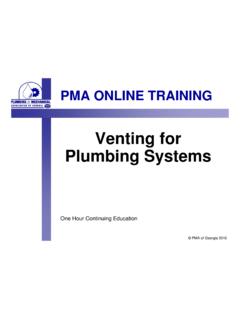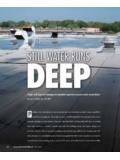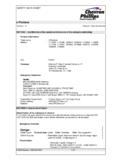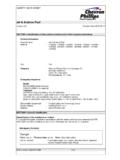Transcription of SAFETY DATA SHEET - Stepan Company
1 SAFETY data SHEET1. IdentificationBTC 2125M-80%Product identifierOther means of identification3202 Product codeBiocidal productPEST CONTROL PRODUCTS ACT REGISTRATION NO. 21407 Recommended useFor industrial use restrictionsManufacturer/Importer/Suppli er/Distributor informationManufacturerStepan CompanyAddress22 West Frontage RoadCompany nameTelephoneGeneral1-847-446-7500 Emergency phone numberMedical1-800-228-5635 Chemtrec1-800-424-9300 Chemtrec Int'l +1 703-527-3887E-mailUSANot , IL 600932. Hazard(s) identificationCategory 3 Flammable liquidsPhysical hazardsCategory 4 Acute toxicity, oralHealth hazardsCategory 2 Acute toxicity, inhalationCategory 1 Skin corrosion/irritationCategory 1 Serious eye damage/eye irritationCategory 1 Hazardous to the aquatic environment, acutehazardEnvironmental hazardsCategory 1 Hazardous to the aquatic environment,long-term hazardNot defined hazardsLabel elementsSignal wordDangerHazard statementFlammable liquid and vapor.
2 Harmful if swallowed. Causes severe skin burns and eye serious eye damage. Fatal if inhaled. Very toxic to aquatic life with long lasting statementPreventionKeep container tightly closed. Keep away from heat/sparks/open flames/hot surfaces. - Nosmoking. Use only outdoors or in a well-ventilated area. Ground/bond container and receivingequipment. Use explosion-proof electrical/ventilating/lighting equipment. Use only non-sparkingtools. Take precautionary measures against static discharge. Do not breathe mist or vapor. Washthoroughly after handling. Do not eat, drink or smoke when using this product. Avoid release tothe environment. Wear protective gloves/protective clothing/eye protection/face protection. Wearrespiratory / 9 Material name: BTC 2125M-80%Material ID: 1794 Product code: 3202 Version #: 05 Revision date: 05-08-2020 Print date: 05-08-2020 SDS USResponseIf swallowed: Immediately call a poison center/doctor. If swallowed: Rinse mouth.
3 Do NOT inducevomiting. If on skin (or hair): Take off immediately all contaminated clothing. Rinse skin withwater/shower. If inhaled: Remove person to fresh air and keep comfortable for breathing. If ineyes: Rinse cautiously with water for several minutes. Remove contact lenses, if present and easyto do. Continue rinsing. Immediately call a poison center/doctor. Specific treatment is urgent (seethis label). Wash contaminated clothing before reuse. In case of fire: Use appropriate media toextinguish. Collect in a well-ventilated place. Keep container tightly closed. Store in a well-ventilated cool. Store locked of contents/container in accordance with local/regional/national/international (s) not otherwiseclassified (HNOC)None Composition/information on ingredientsMixturesCAS number%Chemical nameCommon name and synonyms85409-23-0 (AlternateCAS 68956-79-6)Alkyl (68% C12, 32% C14) dimethylethylbenzyl ammonium chloride4068391-01-5_Alkyl dimethyl benzyl ammoniumchloride (C12-18)4064-17-5 Ethanol97732-18-5 Water< 1068391-04-8_Amines, C12-18-alkyldimethyl< First-aid measuresRemove victim to fresh air and keep at rest in a position comfortable for breathing.
4 Oxygen orartificial respiration if needed. Do not use mouth-to-mouth method if victim inhaled the artificial respiration with the aid of a pocket mask equipped with a one-way valve or otherproper respiratory medical device. Call a physician or poison control center off immediately all contaminated clothing. Rinse skin with water/shower. Call a physician orpoison control center immediately. Chemical burns must be treated by a physician. Washcontaminated clothing before contactImmediately flush eyes with plenty of water for at least 15 minutes. Remove contact lenses, ifpresent and easy to do. Continue rinsing. Call a physician or poison control center contactCall a physician or poison control center immediately. Rinse mouth. Do not induce pain and severe corrosive skin damage. Causes serious eye damage. Symptoms mayinclude stinging, tearing, redness, swelling, and blurred vision. Permanent eye damage includingblindness could importantsymptoms/effects, acute anddelayedIf the product is ingested, probable mucosal damage may contraindicate the use of gastric the affected person of immediatemedical attention and specialtreatment neededEnsure that medical personnel are aware of the material(s) involved, and take precautions toprotect information5.
5 Fire-fighting measuresWater fog. Foam. Dry chemical powder. Carbon dioxide (CO2).Suitable extinguishing mediaDo not use water jet as an extinguisher, as this will spread the extinguishingmediaVapors may form explosive mixtures with air. Vapors may travel considerable distance to a sourceof ignition and flash back. During fire, gases hazardous to health may be hazards arising fromthe chemicalFirefighters should wear full protective clothing including self contained breathing protective equipmentand precautions for firefightersIn case of fire and/or explosion do not breathe fumes. Move containers from fire area if you can doso without fightingequipment/instructionsUse standard firefighting procedures and consider the hazards of other involved methodsFlammable liquid and fire hazards2 / 9 Material name: BTC 2125M-80%Material ID: 1794 Product code: 3202 Version #: 05 Revision date: 05-08-2020 Print date: 05-08-2020 SDS US6.
6 Accidental release measuresImmediately evacuate personnel to safe areas. Keep unnecessary personnel away. Keep peopleaway from and upwind of spill/leak. Eliminate all ignition sources (no smoking, flares, sparks, orflames in immediate area). Wear appropriate protective equipment and clothing during encapsulating, vapor protective clothing should be worn for spills and leaks with no fire. Donot breathe vapor. Do not touch damaged containers or spilled material unless wearingappropriate protective clothing. Ventilate closed spaces before entering them. Local authoritiesshould be advised if significant spillages cannot be precautions,protective equipment andemergency proceduresEliminate all ignition sources (no smoking, flares, sparks, or flames in immediate area). Takeprecautionary measures against static discharge. Use only non-sparking Spills: Stop the flow of material, if this is without risk. Dike the spilled material, where this ispossible.
7 Cover with plastic SHEET to prevent spreading. Use a non-combustible material likevermiculite, sand or earth to soak up the product and place into a container for later product from entering drains. Following product recovery, flush area with Spills: Wipe up with absorbent material ( cloth, fleece). Clean surface thoroughly toremove residual not discharge effluent containing this product into lakes, streams, ponds, estuaries, oceans orother waters unless in accordance with the requirements of a National Pollutant DischargeElimination System (NPDES) permit and the permitting authority has been notified in writing priorto discharge. Do not discharge effluent containing this product to sewer systems withoutpreviously notifying the local sewage treatment plant authority. For guidance, contact your StateWater Board or Regional Office of the and materials forcontainment and cleaning upAvoid release to the environment. Contact local authorities in case of spillage to drain/aquaticenvironment.
8 Prevent further leakage or spillage if safe to do so. Do not contaminate water. Avoiddischarge into drains, water courses or onto the precautions7. Handling and storageVapors may form explosive mixtures with air. Do not handle, store or open near an open flame,sources of heat or sources of ignition. Protect material from direct sunlight. Take precautionarymeasures against static discharges. All equipment used when handling the product must begrounded. Use non-sparking tools and explosion-proof equipment. Do not breathe vapor. Do notget this material in contact with eyes. Do not get this material in contact with skin. Do not taste orswallow. Avoid prolonged exposure. Do not get this material on clothing. Use only outdoors or in awell-ventilated area. Wear appropriate personal protective equipment. Observe good industrialhygiene practices. When using, do not eat, drink or smoke. Wash hands thoroughly after release to the environment. Do not empty into for safe handlingDO NOT CONTAMINATE WATER, FOOD OR FEED BY STORAGE OR DISPOSAL.
9 PESTICIDESTORAGE: Store in a dry place no lower in temperature than 50 F or higher than 120 F. Storelocked up. Keep away from heat, sparks and open flame. Prevent electrostatic charge build-up byusing common bonding and grounding techniques. Store in original tightly closed container. Storein a cool, dry place out of direct sunlight. Store in a well-ventilated place. Keep in an area equippedwith for safe storage,including any incompatibilities8. Exposure controls/personal protectionOccupational exposure limitsUS. OSHA Table Z-1 Limits for Air Contaminants (29 CFR )ValueComponentsTypePEL1900 mg/m3 Ethanol (CAS 64-17-5)1000 ppmUS. ACGIH Threshold Limit ValuesValueComponentsTypeSTEL1000 ppmEthanol (CAS 64-17-5)US. NIOSH: Pocket Guide to Chemical HazardsValueComponentsTypeTWA1900 mg/m3 Ethanol (CAS 64-17-5)1000 ppmNo biological exposure limits noted for the ingredient(s).Biological limit values3 / 9 Material name: BTC 2125M-80%Material ID: 1794 Product code: 3202 Version #: 05 Revision date: 05-08-2020 Print date: 05-08-2020 SDS USEnsure adequate ventilation, especially in confined areas.
10 Eye wash facilities and emergencyshower must be available when handling this engineeringcontrolsIndividual protection measures, such as personal protective equipmentWear SAFETY glasses with side shields (or goggles) and a face shield. Wear a full-face respirator, protectionSkin protectionWear appropriate chemical resistant protectionWear appropriate chemical resistant clothing. Wear protective case of insufficient ventilation, wear suitable respiratory equipment. Use a positive-pressureair-supplied respirator if there is any potential for an uncontrolled release, exposure levels are notknown, or any other circumstances where air-purifying respirators may not provide protectionWear appropriate thermal protective clothing, when hazardsWhen using, do not eat, drink or smoke. Always observe good personal hygiene measures, suchas washing after handling the material and before eating, drinking, and/or smoking. Routinelywash work clothing and protective equipment to remove hygieneconsiderations9.















